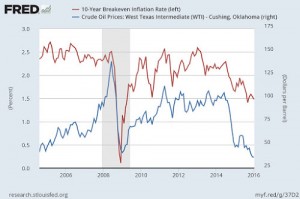The markets are connected via expectations. If there is a price change in one market, then this information is transmitted to other markets pricing in easily assimilated expectations within a similar time horizon. All consumer durables markets have an eye on the future. In other words, they have a financial component although the product which is trading on the market has an industrial use. For example, the oil and bond markets.
The price of oil has fallen to historic lows, at least in real terms. The yield on the US 10-year Treasury bond is declining. If we compare this with that on the bond deflated for inflation, we can see bond investors’ inflation expectations. The higher the estimate for inflation, the greater the bond spread, and viceversa.
In the graph, we compare the variations between the price of oil (the right-hand axis) and the inflation expectations priced in by the bond market (the yield on the nominal bond minus the deflation factor). The result is : expectations for inflation at 1.5% and oil prices under $40 per barrel, at very low levels. There is an obvious correlation between the variations in both inflation and crude prices, although not in terms of levels.
If we want to continue with the comparison, we’ll see that financial markets have become globalised, reflecting world expectations (whether correct or not). That is what Cullen Roche says: that the macroeconomy is affecting financial markets increasingly more than listed companies’ results.
On the other hand, it is difficult to draw any comparison in the labour markets, unless it concerns migratory flows, slow and with long term effects, and not always positive.
In Europe, with a common currency like in the US, the labour market is not homogenous. Although the European financial market works well, its labour market is more rigid and fragmented than that of any country with a similar income level, and of course than the US. And the same goes for any market with a common good, like the automotive market. This comparative increased inflexibility means that the US is better able to absorb financial shocks than Europe, despite the fact its economy is bigger.






